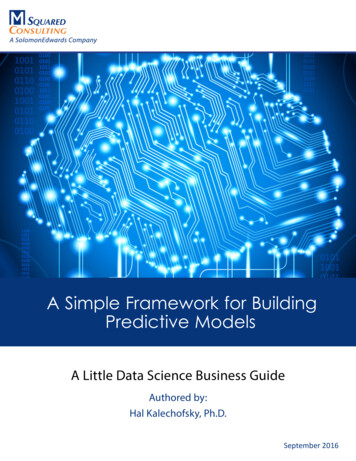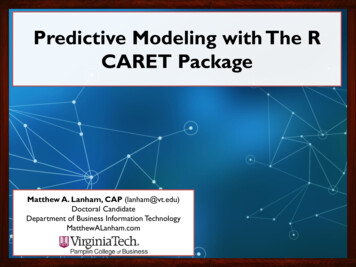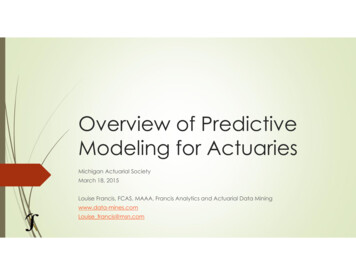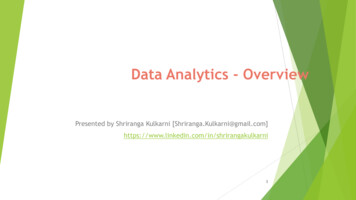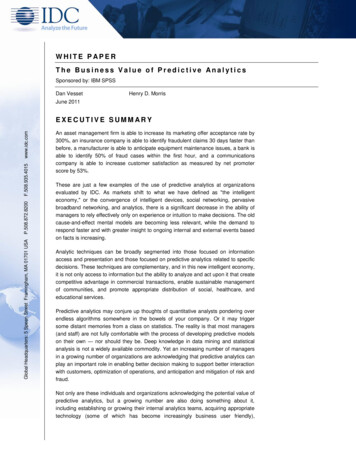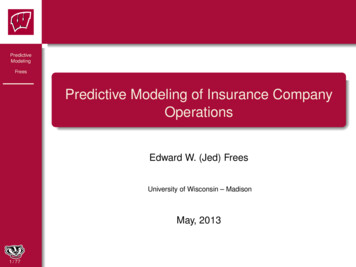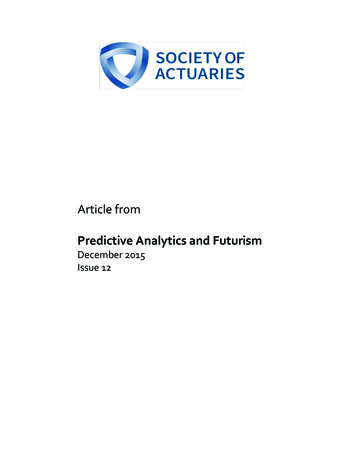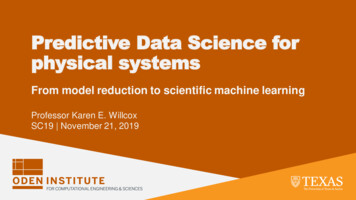
Transcription
Predictive Data Science forphysical systemsFrom model reduction to scientific machine learningProfessor Karen E. WillcoxSC19 November 21, 2019
The TeamMichael KapteynStefanie SalingerDr. David KnezevicLuwen HuangCory KaysMITUT AustinCTO, AkselosMIT Mapping LabAurora Flight SciencesFunding sources: US Air Force Computational Math Program (F. Fahroo);US Department of Energy AEOLUS MMICC (S. Lee, W. Spotz);US Air Force Dynamic Data Driven Application Systems Program (E. Blasch);The Boeing Company;SUTD-MIT International Design Centre
Outline1The Unreasonable Effectiveness ofComputational ScienceFrom forward simulation to predictive data science2Predictive Digital TwinReduced models enable scalable system-levelmodeling & rapid updating with dynamic data3Conclusions & Outlook
1 Unreasonable Effectivenessof Computational Science2 Predictive Digital Twin3 Conclusions & OutlookThe UnreasonableEffectivenessof ComputationalScienceFrom forward simulation topredictive data science
How do we harness the explosionof data to extract knowledge, insightand decisions?BIG DECISIONSPatient-specific prostate tumor modeling (T. Hughes)need more than just big data They need BIG MODELS too.Inspired byCoveney, Dougherty, Highfield “Big data need big theory too”Arctic ocean circulation modeling(A. Nguyen & P. Heimbach)Hurricane storm surge modeling(C. Dawson)
BIG DECISIONSneed more than just big data Complex multiscale multiphysics phenomenadriving the dynamics of high-consequence applicationsHigh dimensional parametersunderlying the characterization of scientific and engineering systemsData are sparse, intrusive and expensive to acquireespecially in the most critical regimesUncertainty quantificationin model inference and certified predictions in regimes beyond training data
BIG DECISIONSneed BIGMODELStoo.“Computational Scienceor Computational Science & Engineering (CSE)is an interdisciplinary field that uses mathematicalmodeling and advanced computing to understandand solve complex problems. At its core CSEinvolves developing models and simulations tounderstand physical/natural systems.BIG DECISIONS must incorporate thepredictive power, interpretability, and domain knowledgeof physics-based models.
What is a physics-based model?A representation of thegoverning laws of nature thatinnately embeds the concepts oftime, space, and causalityExample:equationsof linearelasticity 2𝑢 𝜎 𝜎𝜌 2 𝐹 𝑡 𝑥 𝑦equation of motion(Newton’s 2nd law)1𝜀 𝑢 𝑢2In solving the governing equationsof the system, we constrain thepredictions to lie on the solutionmanifold defined by the laws of nature strain-displacementequations𝜎 𝐶: 𝜀constitutiveequations boundary conditions initial conditionsa mathematicalmodel of how solidobjects deform,relating stress 𝜎,strain 𝜀, displacement𝑢, and loading 𝐹The unreasonable effectiveness of physics-based models [Wigner, 1960]Solving a physics-based model:Given initial conditions, boundary conditions,loading conditions, and system parametersCompute solution trajectories 𝜎 𝑥, 𝑦, 𝑡 , 𝜀 𝑥, 𝑦, 𝑡 , u 𝑥, 𝑦, 𝑡 , A predictivewindow onthe future
Forward simulationsAdvancing scientificdiscovery & engineeringinnovationOptimization & inverse problemsAdvancing estimation,design & controlUncertainty quantificationTowards Predictive ScienceScientific machine learningTowards Predictive Data ScienceHow do we harness the explosion ofdata to extract knowledge, insight anddecisions?
Learningfrom datathrough thelens ofmodels
Learningfrom datathrough thelens ofmodels
1 Unreasonable Effectivenessof Computational Science2 Predictive Digital Twin3 Conclusions & OutlookPredictiveDigital TwinComponent-based reduced models enablescalable predictive modeling &rapid model updating with dynamic data
Digital twins enabledata-driven decisionsHigh-consequence decisions require digital twins that arepredictive reliable explainableVehicle &environmental dataPhysics-basedpredictive modelsPredictive Digital Twin
self-awareaircraftOur digital twin adapts to theevolving UAV structural health providing near real-timecapability estimates that enabledynamic decision-makingsource: stateupdate flightcapabilitiespredictive digital twindynamicallyreplanmission
self-awareaircraftVehicle &environmental dataPhysics-basedpredictive modelsPhysics-based modelssimulate new previously unseen scenariosobey the laws of physicshave quantifiable uncertaintyPredictive Digital Twinparameters represent real-world quantitiesBut physics-based models are too complex and too expensive foruse in near real-time onboard decision-making
dimension 104 109solution time minutes / hours dimension 101 103solution time secondsProjection-based model reduction1 Train: Solve PDEs to generate training data2 Identify structure: Compute a low-dimensional basis3 Reduce: Project PDE model onto the low-dimensional subspace
Machine learningReduced-order modeling“The scientific study of algorithms & statisticalmodels that computer systems use to perform aspecific task without using explicit instructions,relying on patterns & inference instead.” [Wikipedia]“Model order reduction (MOR) is atechnique for reducing the computationalcomplexity of mathematical models innumerical simulations.” [Wikipedia]What is the connection between reduced-ordermodeling and machine learning?Model reduction methods have grown from CSE, with a focus on reducing high-dimensionalmodels that arise from physics-based modeling, whereas machine learning has grown fromCS, with a focus on creating low-dimensional models from black-box data streams.[Swischuk et al., Computers & Fluids, 2018]Can we get the best of both worlds?
Reduced-order modeling leads to low-costphysics-based models that enablepredictive digital twinsChallenges & limitationstraining is expensivescaling to high-dimensional parametersdealing with discontinuous parameter dependenceApproachStatic-Condensation Reduced-Basis-Element (SCRBE) method [Huynh 2013]“Divide and conquer”
Example component: section of a component interiorcomponent portYoung’s modulusPoisson’s rationumber of pliesply angles
Example component: section of a g’s modulusPoisson’s rationumber of pliesply angles 𝑐component interiorcomponent portdamageparametersreduced stiffnessmaterial losscrack lengthdelamination size physics-based PDE model(linear elasticity damage)
Example component: section of a g’s modulusPoisson’s rationumber of pliesply angles 𝑐component interiorcomponent portdamageparametersreduced stiffnessmaterial losscrack lengthdelamination size physics-based PDE model(linear elasticity damage)computational mesh
local effects(component parameters) interactions(assembly parameters)A complex nonlinearsystem is more than justthe sum of its pieces context(loads parameters)
Flight test vehicleCustomized 12ft Telemaster aircraftCustom wing sets: pristine & damagedAccelerometers vibration dynamicstrain sensors24 strain gauges per wingTemperature,pressure andhumidity sensors3 axisaccelerometer3 axis gyroDual high-frequencydynamic strain andvibration sensors*Willcox has a family member who is co-founder of Divinio. Purchase of the sensors for use in theresearch was reviewed and approved in compliance with all applicable MIT policies and procedures.Internal structure
Physics-based Digital TwinFinite element model: multiple materialtypes (carbon fiber, carbon rod,plywood, foam) & multiple elementtypes (solid, shell, beam)Reduced model: 0.03 seconds perstructural analysis (cf. 55 seconds forthe finite element model)top skinshearwebroot top skinflapssparcapscircular rodsribsbottom skinaileronlinkagesReduced model:1000x speedup,30 solves/minuteInternal structure
From component-based model to digital twin: Physics-based libraryOffline: Construct a library of damage statesfor each component Create multiple copies of each component Train components for parameter rangesof interest (local interactions) Compute associated aircraft structuralload constraints (context)damage region80%60%increasing effective damage40%(reduction in stiffness)20%0%
From component-based model to digital twin: Interpretable machine learningComponent 1Offline: Train a classifierusing simulation data Optimal Classification Trees𝑛sensor 22 495?Sensor 8 Highly interpretable Natural framework forsensor selection Online classification is rapid𝑦𝑦sensor 22 383?𝑦𝑛80%60%40%𝑛sensor 22 351?𝑦𝑛20%pristineSensor 22Component 2sensor 24 103?120𝑦110SensorSensor 2424[Bertsimas & Dunn, 2017]sensor 22 429?80%60%40%20%0%908060sensor 16 0.37*(sensor 24) 112?80%100708090Sensor 1616Sensor100𝑛𝑦sensor 16 1.64*(sensor 24) 237?𝑦𝑛60%40%𝑛sensor 16 73?𝑦20%𝑛pristine
Flight of the UAVConservative flight pathSensor 22Sensor 12Sensor 24Health e flight pathStrain MeasurementsRapid ClassificationTimeSensor 22 429Sensor 22 393Sensor 22 351pristine20%Sensor 22 49540%60%80%
1 Unreasonable Effectivenessof Computational Science2 Predictive Digital Twin3 Conclusions & OutlookConclusions &OutlookFrom forward simulations topredictive data science
Predictive Data ScienceLearning from data through the lens of models is a wayto exploit structure in an otherwise intractable problemIntegrateheterogeneous, noisy& incomplete dataEmbed domainknowledgeRespect physicalconstraintsBring interpretabilityto resultsGet predictions withquantifieduncertainties
Data SciencePredictiveData ScienceComputationalScience &EngineeringRevolutionizing decision-making forhigh-consequence applications inscience, engineering & medicine
Data SciencePredictiveData ScienceComputationalScience &EngineeringNeeds interdisciplinary research & educationat the interfaces of computer science,mathematics, statistics, high performancecomputing, and applications across science,engineering and medicine
Interdisciplinary research & education incomputational engineering & sciencesdeveloping high-performance computing solutions to society's big problemsODEN.UTEXAS.EDU
scalable predictive modeling & rapid model updating with dynamic data 1 Unreasonable Effectiveness of Computational Science 2 Predictive Digital Twin 3 Conclusions & Outlook. High-consequence decisions require digital twins that are predictive reliable explainab



